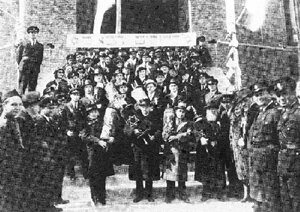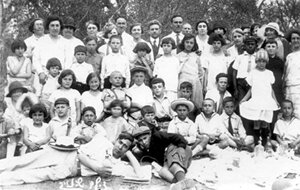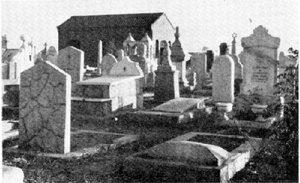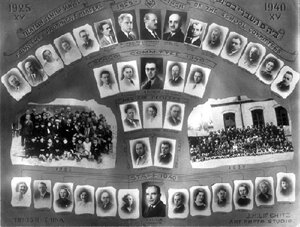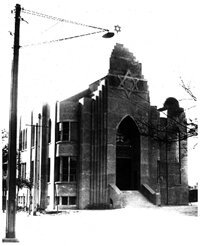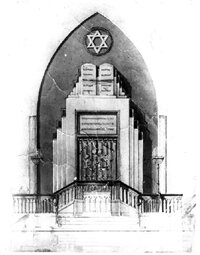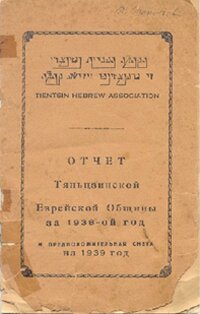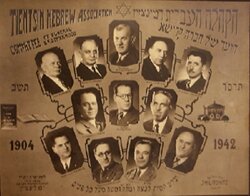| Historic Community of Tianjin, China |

|

|
|
Tianjin, also known as Tientsin, is an urban area, located along the Hai He River. It now ranks as the third largest urban area in modern China, after Shanghai and Beijing.
A news article in the Jewish Times Asia, in April 2007, reported the current controversy over the fate of the former Tianjin Synagogue. The Synagogue was built in 1939 by the Tiajin Jewish Union. After the Jewish community was dispersed, came under the control of the Tiajin Catholic Church. Igud Yotzei Sin (Association of the Former Residents of China) made a formal plea to completely rebuild this crumbling historic landmark. A mere restoration does not seem practical due to the extensive damage that the structure has suffered over the years.
The Central Archives for the History of the Jewish People (CAHJP) hold the archives of hundreds of Jewish communities including original files from the archives of the Jewish community of Tientsin (1920-1957) deposited by Igud Yotzei Sin . The archives include a number of documents and photographs of Jewish institutions and prominent community members in Tientsin. The CAHJP is located on the Giv’at Ram Campus of the Hebrew University in Jerusalem. Additionally, a few of the former residents of the Jewish community of Tiajin have published their personal memoirs. One notable published novel is China Dreams: Growing Up Jewish in Tientsin by Isabelle Zimmerman Maynard. Maynard, recently deceased, was born in 1929 in Tientsin. She was the daughter of Jewish Russian refugees who fled to China to seek relief from the Russian Revolution. Her story, like others, gives much insight as to the status and lives of the former Jewish residents of China. Along with the other Russian Jews, they lived somewhat between worlds, holding passports stamped with “stateless.†Like other Europeans, she and her contemporaries didn’t learn Chinese and lived sheltered in one of the “concessions†carved out by the European communities, cut off from the surrounding impoverished Chinese. She left China for the United States in late 1940’s.
Not unlike the history of the Jewish community of Harbin, Tianjin saw its first Jewish residents in the early 1900’s. There are reports of Jewish businessmen in the city as early as 1860, during the second Opium War, however it is likely that these traders merely used the city as a base for trade and commerce like their non-Jewish fellow European counterparts. In 1900, the first wave of Jewish settlers began to arrive. The early days of the community, in 1904 list ten Russian-Jewish families as residents. This small group formally registered their community. The Hebrew Association of Tientsin (THA) was officially registered with the Russian Imperial Consulate in Tientsin. They acquired a plot of land for a cemetery and shortly thereafter began to regularise religious worship. The foundations for a Jewish relief organisation were also quickly established to provide for those in need.
The community rapidly expanded as the situation in Russia worsened for the Jews. By 1917, the revolution in Russia accounts for a population expansion to as many as 500-600 Jewish families who found their way to Tientsin via Manchuria. These Jewish residents were involved in a variety of occupations and trades. There were a large number of respected physicians as well as businessmen, craftsman, jewelers, traders, engineers, lawyers and teachers. Wealthier families often immediately went on to places like the United States and Europe via Shanghai. Others adapted rapidly to their new surroundings and contributed significantly to the already structured presence of the community. In 1920, the THA built a beautiful synagogue, employed a rabbi and a shochet and were able to provide full religious services. A number of committees were formed under the framework of the THA including committees for the development of social activities, cultural actitivities, arbitration, and a committee for Eretz Israel affairs. A hospital, located at No. 66 Street, was similarly founded to treat Jewish patients. The hospital also provided medical assistance for people of all nationalities who could not obtain medical services from other communities. Likewise, the Benevolent Society was also formed in 1920 in order to assist new Jewish refugees in need and help them during their transition period as they settled into life in China. A home for the elderly was also erected. The information office for Eretz Israel was established in 1921, later renamed The Zionist Organisation of Tientsin. This organisation was a central force in the creation of much of the community’s social and cultural activities. The Tientsin Jewish School (TJA) was established in 1925 at No.126 in the old British concession. It was a truly remarkable institution that made its mission to provide free education in Hebrew and English to those in need. Most of the students were in fact grant recipients of the free education at that time. Many received discounts, while others were able to study entirely free of charge. The funding for the school’s budget was provided through donations as well as through income received through the community’s annual party to celebrate the New Year. The curriculum was based on the British Grammar School system and the level of English was such that students were reportedly able to sit for the Cambridge Overseas Examinations. The extensive curriculum incorporated the following subjects: Hebrew, Bible (Reading in Hebrew), Jewish History, English, Chinese, Russian, English Literature, General History, the History of England, Geography, The reading of the Bible in English, Arithmetic, Algebra, Geometry, Handicrafts, Gymnastics, Art, and Singing. Interestingly, in 1935, the student body of 95 included 79 Jewish students as well as 16 non-Jewish students of different nationalities. By 1936 the student body reached 110 students and 15 teachers. In 1928, a dramatic society was established called Kunst, or ‘art’ in German. This society evolved into the social club and was expanded to include club facilities, a restaurant, meeting halls, a theater and an impressive library collection. In 1937, the Jewish Club or Kunst Club was built at No.24 Street in the former English concession (modern Qufu Road). The club, after it ceased to be used for its original purpose, became the Tianjin People’s Art Gallery. It was entirely demolished in 1999. The Charity Society was established in 1931 to provide interest free loans to needy applicants.There were also other social welfare schemes to provide food for the needy. The Women’s International Zionist Organization (WIZO) was also established in 1931 and the youth movement Betar followed in 1932. The Jewish Agency set up a permanent presence in Tientsin in 1936, but a presence was recorded and activities conducted beginning in 1932-1933. The Hebrew Association of Tientsin (THA), served as a central committee, coordinating the numerous different organisations under one general umbrella organisation of which the directors were the presidents of the various individual clubs and programmes. It functioned in this ‘umbrella’ capacity beginning in 1934. Functions were categorised by the following committees: Religious, Cultural, Arbitration, Archival and Taxation. In 1935, a resolution was passed creating a mandatory tax on community members, on a sliding scale according to the individual’s means. Births and deaths were also registered by the THA.
By 1935, Tiajian, like other cities in China, opened its doors to an influx of Jewish refugees fleeing Nazi persecution. The Jewish population expanded to about 3,500 in 1935 and 5,000 at its peak. Unlike other Jewish communities in China, however, the community was centered on the original organisations established by the former Russian Jews. These organisations expanded to include and absorb later arrivals to the community. On 8 December 1941 Japanese occupation of the municipality began. Japanese occupation lasted until 15 August 1945, the surrender of Japan marking the end of World War II. After 1945, Tianjin became base to American forces until they pulled in June 1947. Communist forces took power in Tianjin on 15 January 1949. The end of the 40s, saw the end of the Jewish community. Long unable to call places in their memories like Russia or Germany home, they mainly left for places like Israel, Australia and the United States. The eventual fate of the long abandoned Synangogue, which has suffered severe damage, remains unknown. The Jewish cemetery has also been destroyed but many of the former Jewish residences can still be found throughout the city. Despite years of war, earthquakes and rapid urban expansion, the former Jewish presence can still be felt throughout the Jewish ghetto. It was a community small in terms of numbers but strong in its commitment to building a life for itself in the throws of turmoil and displacement. Photographs and information contributed by Igud Yotzei Sin  (Issue February 2008) |


















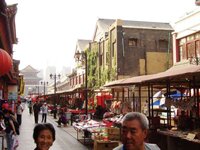 Â
 